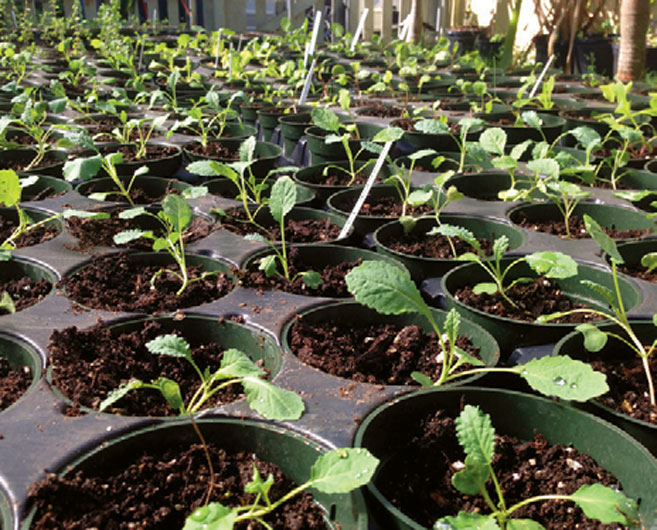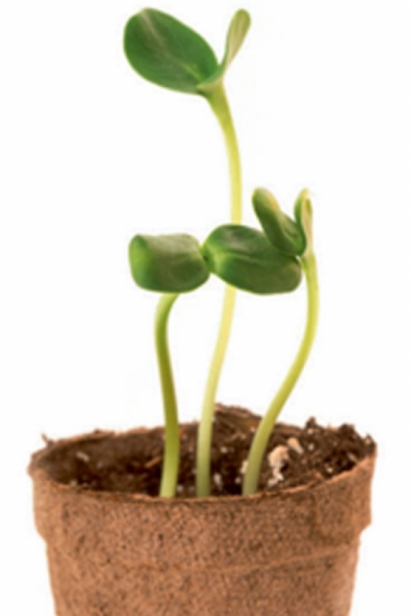Get Those Seedlings Started
Summer heat, frequent downpours and humidity make growing some favorites difficult or impossible now for the home gardener. Use these long days of summer to plant seeds for your fall garden.
Starting your own seedlings now gives you a head start when you begin your vegetable garden in autumn.
Sure, it may be easier to buy seedlings from Home Depot or a big-box retailer, but the plants aren’t organic or grown locally and your choices are limited. Their varieties may not do well in South Florida. Choose your own seeds from trusted sources and you’ll not only get exactly what you want, you’ll also save money – seeds are cheaper than plants. And if you saved seeds from previous seasons, you can plant them to enjoy tried-and-true produce year after year.
LOCATION, LOCATION, LOCATION
To start plants from seed successfully, first find a suitable location for planting. How much space you need depends on how much you want to plant. For the average home gardener, one average-sized table is usually big enough. Position this table where it gets lots of light, ideally filtered by a tree. If the site is too dark, seedlings will grow lanky and have weak stems, usually resulting in a weaker plant. But make sure your site doesn’t get nonstop light; if the seedlings get direct sun all day, there’s a risk they will get too hot or dry out. Use shade cloth to make light less intense.
You’ll also need to protect the seedlings from hard rains that can kill young fragile seedlings. It’s a major blow to invest materials and time into planting your own seedlings, only to have them get wiped out by a rainstorm. Position your seed-starting table under an overhang, or set up a clear plastic sheet overhead to block the hard rain. You will have to water your seedlings since they won’t be getting rain water. Usually young seedlings prefer to be misted. Large drops of water can bruise young leaves or compact the soil. If you don’t have time to mist the seedlings 2-4 times a day, set up an automated irrigation system to do the job, using an existing hose spigot. A fan nearby can help dry wet plants. When leaves are too moist, you could face problems with bacteria or mold. A fan also encourages stems to grow strong.
THE RIGHT POT
What containers are best for your seedlings? Plastic trays fit many plants in little space – usually there are 40 to 100 cells per tray. The smaller the cell, the sooner the plants will need to be transplanted into the garden. They’ll also need more frequent misting. Other options include:
• Egg cartons (with holes, if plastic)
• Paper cups, with holes made in bottom for drainage
• Small plastic pots (reusable but not biodegradable)
• Peat pots (biodegradable but not reusable)
• Pots made from folding old newspaper (biodegradable but not reusable)
GROWING MEDIUM
The key is to have both fertility and proper drainage (not too dry, not too wet). Often beginning gardeners prefer to use soilless germination mixes that do not have compost because they won’t compact or have diseases. One basic mix is 1/3 perlite, 1/3 vermiculite, 1/3 peat or coir. If you’re using a soilless mix, apply liquid fertilizer two or so weeks after germination. Another mix with compost is 1/4 peat or coir, 1/4 compost or castings, 1/4 perlite and 1/4 vermiculite. Premoisten the mix before putting it into the containers, particularly if it’s dry.
TROUBLESHOOTING
Closely monitor your seedlings. If they’re growing too lanky, they need more light or they’re being overwatered. Let the growing medium dry just a little bit between waterings. If the seedlings are wilting and the soil is dry, they may need more water. Light, wind, rain, temperature and humidity play a role in how often seedlings need to be watered.
Keep a lookout for snails – they can quickly eat your tender seedlings. They’re a bigger problem in rainy weather and if your seedling area is located on the floor, not raised on tables.
TRANSPLANTING
When the roots are coming out of the bottom of the container, it’s time to transplant your seedlings into the garden or into a larger container. Another sign that it’s time to transplant is if the soil is drying out noticeably faster than usual, as bigger plants drink more water.
Have an edible gardening question? Email Dylan at garden@ediblesouthflorida.com.
{ Where to Find Seeds }
Baker Creek Heirloom Seeds
rareseeds.com
ECHO (Fort Myers)
echobooks.org
Eden Organic Nursery Services (Hallandale)
eonseed.com
Johnny’s Seeds
johnnyseeds.com
Mary’s Heirloom Seeds (Hollywood)
marysheirloomseeds.com
Peaceful Valley
groworganic.com
Seeds of Change
seedsofchange.com
Southern Exposure Seed Exchange
southernexposure.com






